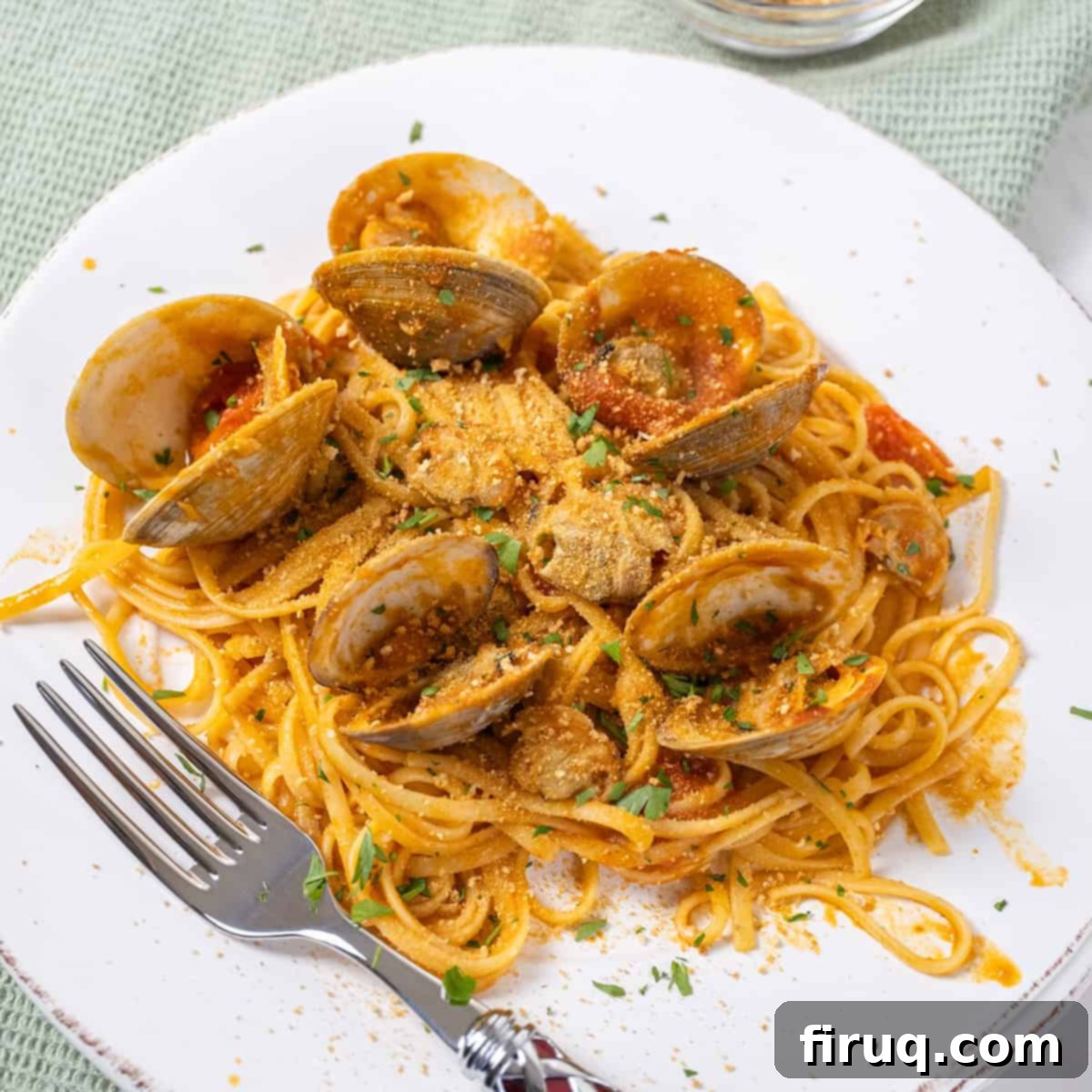Authentic Linguine with Red Clam Sauce: A Vibrant Summer & Holiday Favorite
Imagine a dish that perfectly captures the essence of summer, bursting with the fresh flavors of ripe cherry tomatoes and fragrant garlic, all brought together with succulent clams. Our Linguine with Red Clam Sauce is exactly that – a truly refreshing and incredibly satisfying meal, topped with crispy, toasted breadcrumbs for an added layer of texture and savory depth. It’s a cherished recipe in our home, so much so that we’ve affectionately nicknamed it “Linguine Clamato.”
While it shines as a quintessential summer pasta, this vibrant red clam sauce also holds a special place in our holiday traditions. Its bright flavors offer a delightful contrast to richer festive fare, making it a perfect addition to a Christmas Eve spread. We often pair it with other seafood classics like Fried Flounder Oreganata, creating a memorable and delicious holiday meal that delights everyone at the table.
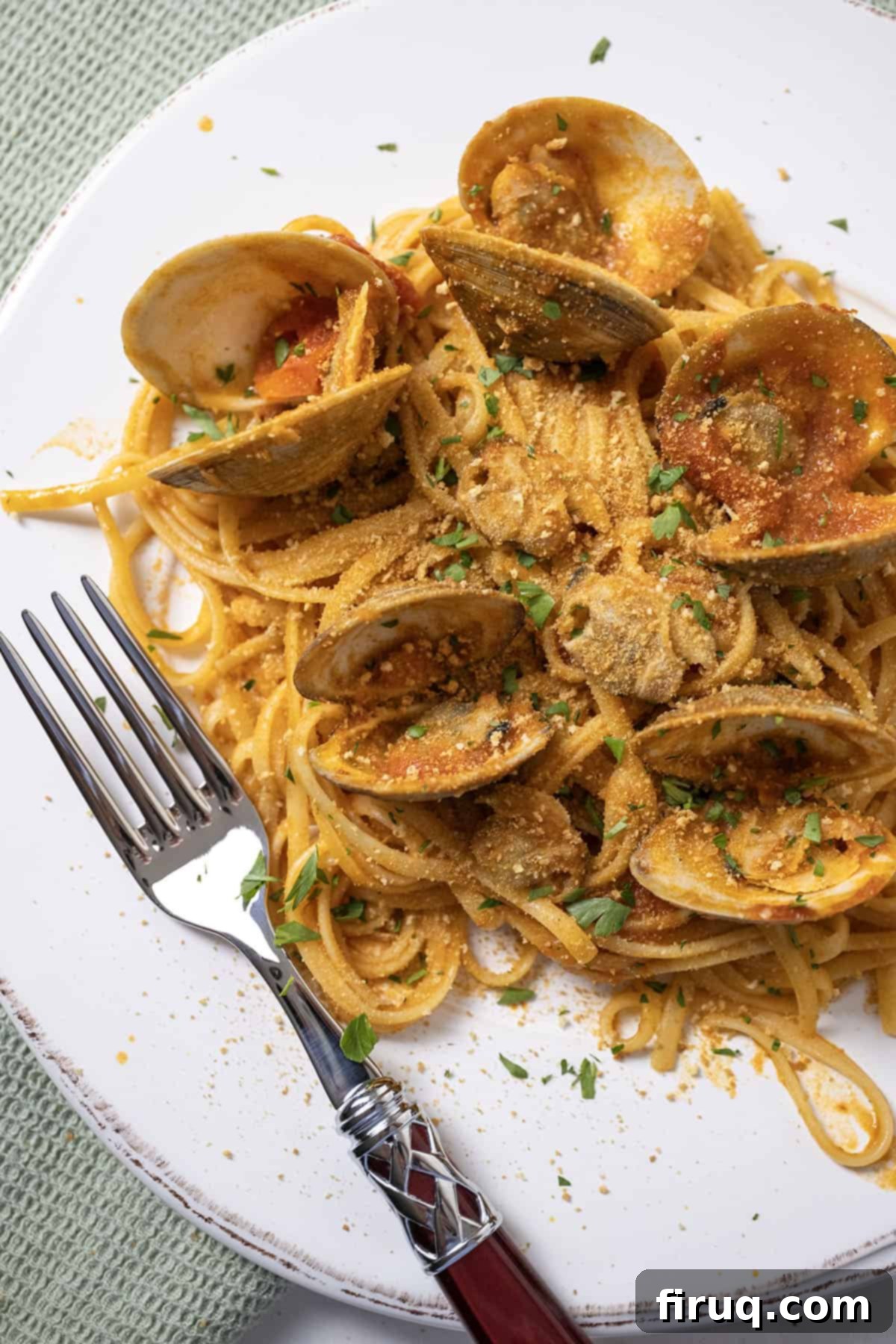
Craving more incredible seafood pasta creations? Don’t miss our bold Shrimp Fra Diavolo with Linguine for a spicy kick, or our classic, garlicky Shrimp Scampi.
[feast_advanced_jump_to]
The Vibrant Appeal of Our Summer Red Clam Sauce
You absolutely *must* make this version of linguine with clams this summer! While traditional Linguine with Clams (often made with a white wine sauce) is an all-time favorite of mine, I usually find myself gravitating towards it more as the weather cools. However, when the warm sun hits and vibrant cherry tomatoes are abundant and perfectly ripe, I crave the bright, acidic burst that only fresh tomatoes can provide in a seafood pasta. This red clam sauce recipe brilliantly captures that summery essence.
A key aspect of this dish, and one deeply rooted in authentic Italian tradition, is the absence of cheese. In Italy, particularly in coastal regions, seafood is typically not paired with cheese. This tradition stems from historical factors, as cheese production was historically concentrated inland, far from the fishing communities on the coastline. Beyond geography, there’s a culinary philosophy at play: cheese, with its strong, pungent flavors, can often overpower the delicate taste of fresh seafood. To achieve a satisfying texture and rich umami without cheese, we use perfectly toasted breadcrumbs. These golden, crispy crumbs provide a delightful contrast and a savory depth that mimics the satisfying crunch and flavor often associated with grated Parmesan, allowing the fresh flavors of the clams and tomatoes to truly shine. While I highly recommend embracing the cheese-less tradition for this seafood pasta, feel free to experiment if you must – but promise me you’ll try it with the toasted breadcrumbs first!
Essential Ingredient Insights & Smart Substitutions
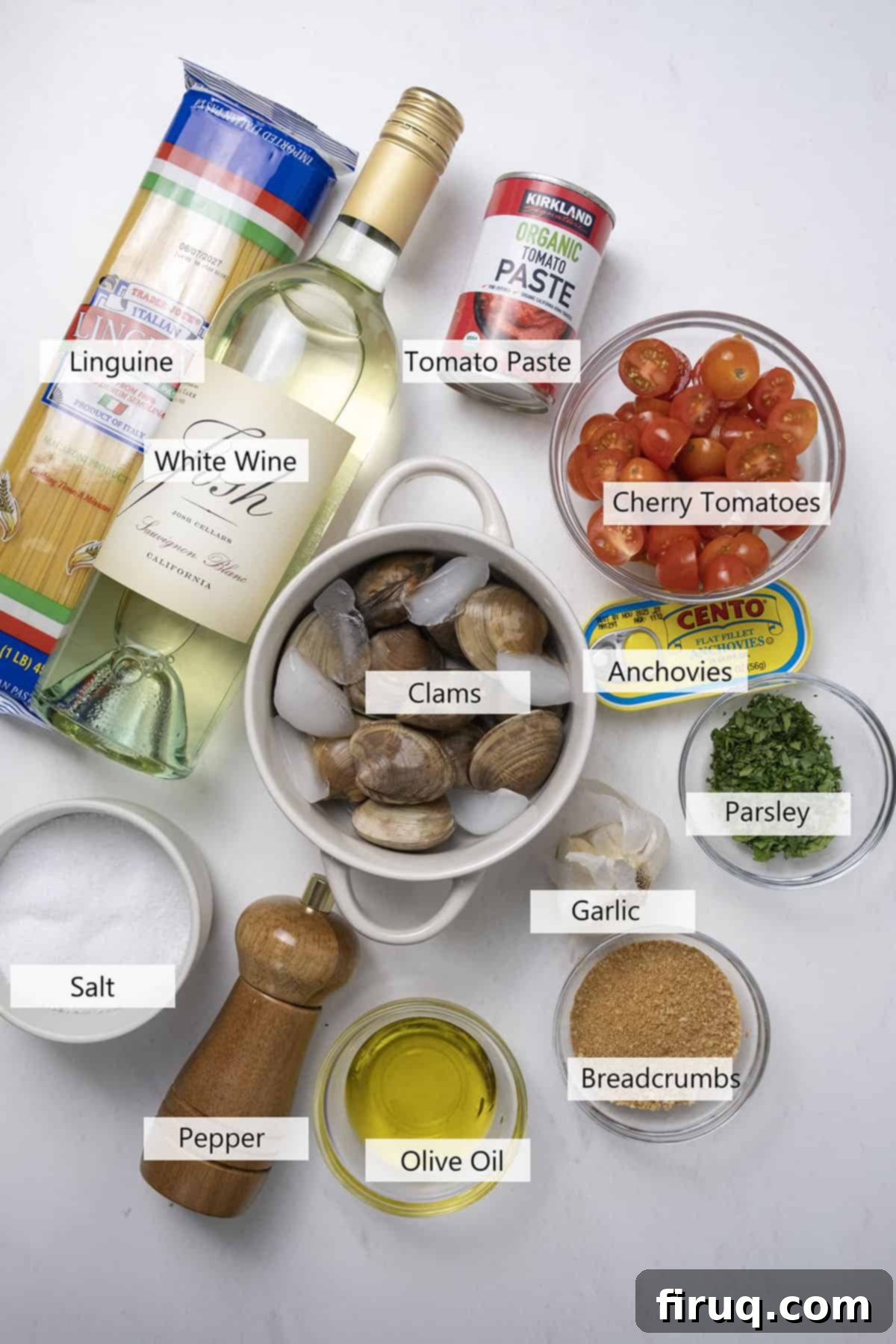
To create the best Linguine with Red Clam Sauce, starting with quality ingredients is crucial. Here’s a closer look at the key components and how you can adapt them:
Toasted Breadcrumbs: The Secret to Umami & Texture. As mentioned, toasted breadcrumbs are a fantastic and traditional alternative to cheese in seafood pasta. They provide a wonderful textural contrast and a savory, nutty flavor that complements the clams without overshadowing them. While you *could* substitute Parmesan, I strongly advise against it for this particular recipe to truly honor the Italian tradition and let the seafood sing. The crispy breadcrumbs offer a satisfying “crunch” that makes you forget all about cheese.
Anchovies: Your Umami Powerhouse. Many people hesitate when they see anchovies on an ingredient list, often asking if they can be omitted. My firm recommendation is to keep them in! When cooked, anchovies melt into the olive oil, completely dissolving and leaving no trace of a “fishy” taste. Instead, they provide a deep, savory umami richness that forms the backbone of the sauce, elevating all the other flavors. If you absolutely must leave them out, be sure to add a little extra salt to the sauce to compensate for the lost savory depth.
Fresh Clams: The Heart of the Dish. The quality of your clams will significantly impact this recipe. If you can, always opt for fresh clams. I typically use little neck clams or cherrystone clams for this recipe. Little neck clams are often considered ideal for pasta due to their smaller size and sweeter, more tender meat. Cherrystones are a bit larger, offering a more substantial bite. When selecting fresh clams, look for ones with tightly closed shells. Discard any that are open and don’t close when tapped. If fresh clams are unavailable, you can use good quality canned clams, but be aware that the sauce may be slightly thicker, and the overall flavor might be less vibrant. If using canned, drain them well but reserve some of the clam juice to add to the sauce for extra flavor.
*Please see the recipe card below for precise measurements and a complete list of ingredients.
The Crucial Step: Purging Your Clams for a Gritty-Free Experience
One of the most vital steps in preparing any fresh clam dish, and especially this linguine with red clam sauce, is purging the clams. This process ensures that you remove any sand or grit that the clams may have accumulated, preventing an unpleasant crunchy surprise in your otherwise delicious pasta. Trust me, I’ve learned this the hard way enough times to know how important it is!
Here’s how to do it effectively:
- Initial Scrubbing: Begin by thoroughly scrubbing the outside of each clam under cold running water. Use a stiff brush to remove any dirt or debris clinging to the shells.
- First Saltwater Bath: Place the cleaned clams in a large bowl filled with cold, salty water. The salt concentration should mimic that of seawater – about 1 tablespoon of salt per quart of water. The clams, being filter feeders, will open up in this environment and naturally expel any sand or impurities they’ve ingested. Let them sit for at least 60 minutes.
- Second Saltwater Bath: After an hour, carefully remove the clams from the bowl (leaving any expelled grit behind) and discard the dirty water. Rinse the bowl and refill it with fresh cold, salty water. Return the clams to this new bath and let them sit for another 60 minutes.
- Final Rinse: Just before you’re ready to cook, remove the clams from their bath and give them one final quick rinse under cold running water. They should now be perfectly clean and ready for your sauce.
When purchasing clams, always remember to ask your fishmonger if they have already been “purged.” If they have, you might be able to skip this step, saving you some time. However, I always purge my clams as a fail-safe, especially if I don’t plan to cook them immediately. It’s also an excellent way to keep them alive and fresh until cooking. This is a practice I always follow when preparing dishes like my beloved Italian Stuffed Baked Clams.
Crafting Your Delightful Linguine with Red Clam Sauce: A Step-by-Step Guide
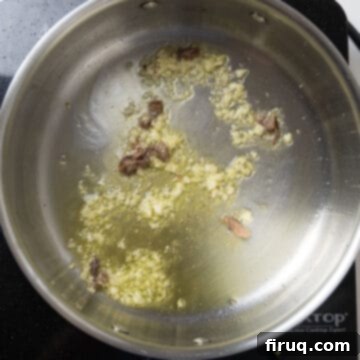
Step 1: Build the Flavor Base. In a large saucepan, add 2 tablespoons of olive oil and heat it over medium heat until it’s shimmering, indicating it’s ready. Add the minced garlic and anchovy fillets. Sauté gently, stirring frequently, until the garlic becomes wonderfully fragrant and lightly golden – be careful not to burn it! The anchovies will slowly dissolve into the oil, infusing it with their incredible umami depth.
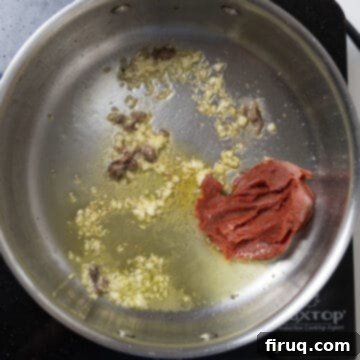
Step 2: Caramelize the Tomato Paste. Add the tomato paste to the saucepan and stir it well to combine with the garlic-infused oil. Allow the tomato paste to caramelize on the bottom of the pan for about two minutes. This crucial step deepens its flavor, adding a rich, concentrated sweetness that forms the core of your red clam sauce.
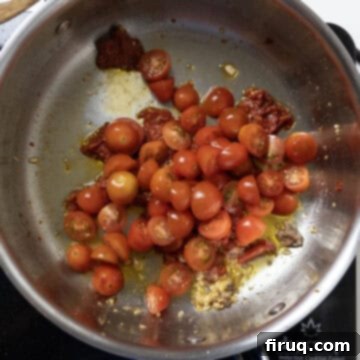
Step 3: Introduce the Fresh Tomatoes. Add the halved cherry tomatoes to the saucepan. Gently stir and allow them to simmer, breaking down naturally. Sauté for 5-8 minutes, using a wooden spoon to occasionally press them against the side of the pan to help them burst and release their juices. This creates a beautifully fresh and chunky tomato base for your red clam sauce.
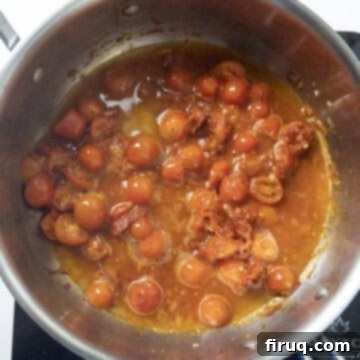
Step 4: Deglaze and Start the Pasta. Pour in the white wine and bring the sauce to a gentle simmer. Let it cook for about 5 minutes, allowing the alcohol to cook off and the flavors to meld beautifully. During this time, set a large pot of water to boil for your linguine. Once boiling, add a generous amount of salt (it should taste like the sea!) and then add the linguine, boiling until it’s just before al dente – remember it will finish cooking in the sauce.
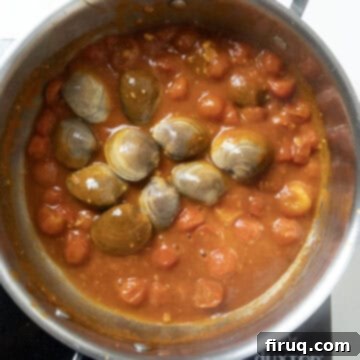
Step 5: Steam the Clams. Add the thoroughly rinsed, purged clams to the simmering sauce. Cover the saucepan tightly and allow the clams to steam for 3-4 minutes, or until all the clam shells have opened wide. Discard any clams that remain closed after this time, as they were likely dead before cooking and are not safe to eat.
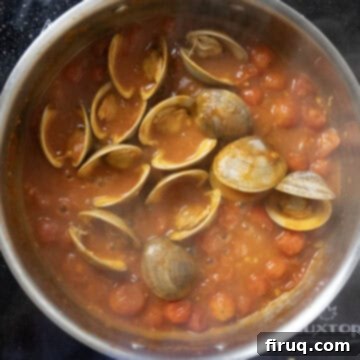
Step 6: Introduce the “Liquid Gold” Pasta Water. Ladle about ½ cup of the starchy pasta water from your boiling linguine into the clam sauce. The starch in the pasta water helps to emulsify the sauce, making it wonderfully creamy and rich without the need for actual cream or cheese. Continue simmering the sauce on low heat until your pasta is perfectly al dente.
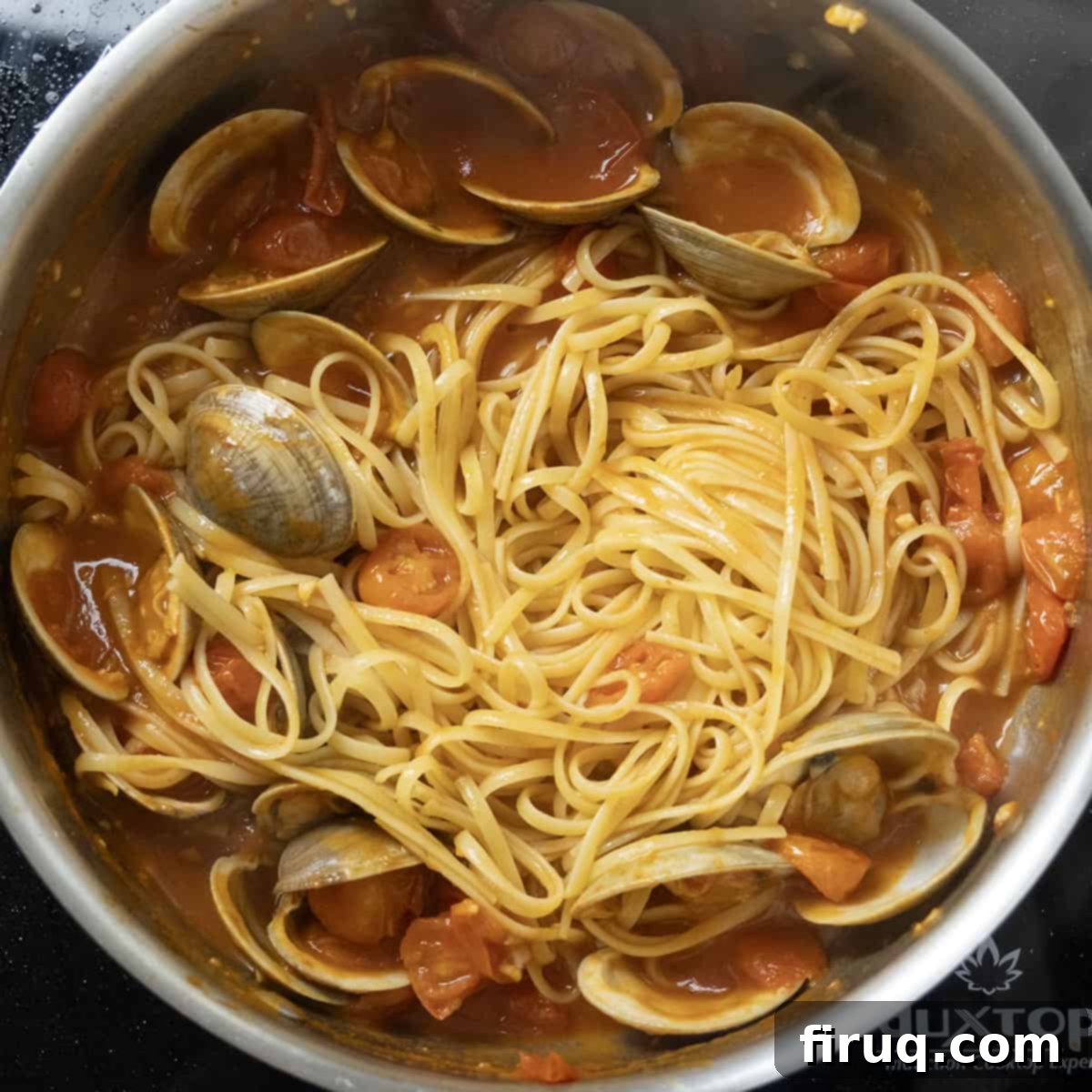
Step 7: Finish & Serve. Transfer the al dente pasta directly into the saucepan with the clam sauce. Stir vigorously to combine, ensuring every strand of linguine is beautifully coated in the rich red sauce. Allow the pasta to cook for another 2-3 minutes in the pan, absorbing the flavors and thickening the sauce slightly. Remove from heat and serve immediately, generously topping each plate of Linguine with Red Clam Sauce with your freshly toasted breadcrumbs for that irresistible crunch and savory finish.
Pro-Tips for Perfect Red Clam Linguine
- Master the Clam Purge: Your Ultimate Grit-Free Guarantee. As highlighted earlier, purging the clams is unequivocally the most crucial step in this recipe. While it doesn’t add a special flavor, skipping it can literally ruin the entire dish by filling it with unpleasant sand and grit. You’ll spend all that effort only to discover a mouthful of sand, which is incredibly disappointing. Please, PLEASE take the time to scrub them thoroughly under cold water and then let them soak in two changes of cold, salty water for an hour each. This mimics their natural environment and encourages them to expel any sand they’ve ingested. It’s a small investment of time that yields immense rewards in terms of enjoyment.
- Embrace the “Liquid Gold”: The Magic of Starchy Pasta Water. Don’t underestimate the power of pasta water in recipes like this. This cloudy, starchy water is often referred to as “liquid gold” by Italian chefs for a reason! The starches released from the pasta during cooking help to emulsify the sauce, binding it together and creating a luxuriously creamy and velvety texture. Think about its transformative effect on dishes like Spaghetti Carbonara, where it’s essential for creating a rich, silky sauce without cream. Adding pasta water to your clam sauce will achieve a similar creaminess, ensuring the sauce clings beautifully to every strand of linguine, all without the need for cheese or heavy cream.
- Perfect Timing: The Key to Tender, Not Rubbery, Clams. Clams cook very quickly, and overcooking them will result in a tough, rubbery texture. To avoid this, it’s essential to time your pasta perfectly. Aim to have your linguine finish cooking to just before al dente (meaning it’s still slightly firm to the bite) at the exact moment your clams are opening in the sauce. This allows you to immediately add the pasta to the sauce and toss it together for those final minutes of cooking, ensuring the clams remain tender and delicious. Discard any clams that do not open, as they were likely dead before cooking.
The Humble Brilliance of Toasted Breadcrumbs
Toasted breadcrumbs are a deceptively simple yet profoundly effective addition to many Italian dishes, especially seafood pasta. They offer a delightful textural crunch and a nutty, savory flavor that makes them an excellent substitute for grated Parmigiano-Reggiano, particularly in dishes where cheese might traditionally be omitted. Making them is incredibly easy:
Simply place a small pan on your stovetop over medium heat. Add your desired amount of plain or panko breadcrumbs. Toss them continuously with a wooden spoon or spatula until they turn golden brown and smell wonderfully toasty – this usually takes only a few minutes, so watch them closely as they can burn quickly. Once golden, remove them from the heat and set aside.
Historically, before hard cheeses became widely accessible across all regions of Italy, particularly in coastal areas, toasted breadcrumbs were a common and ingenious culinary solution used in place of Parmigiano. They provided a similar savory, textural element to pasta dishes. You can use these versatile toasted breadcrumbs on any seafood pasta to add an extra layer of flavor and crunch, such as our classic Linguine with Clams or even a reimagined Shrimp Scampi Without Wine.
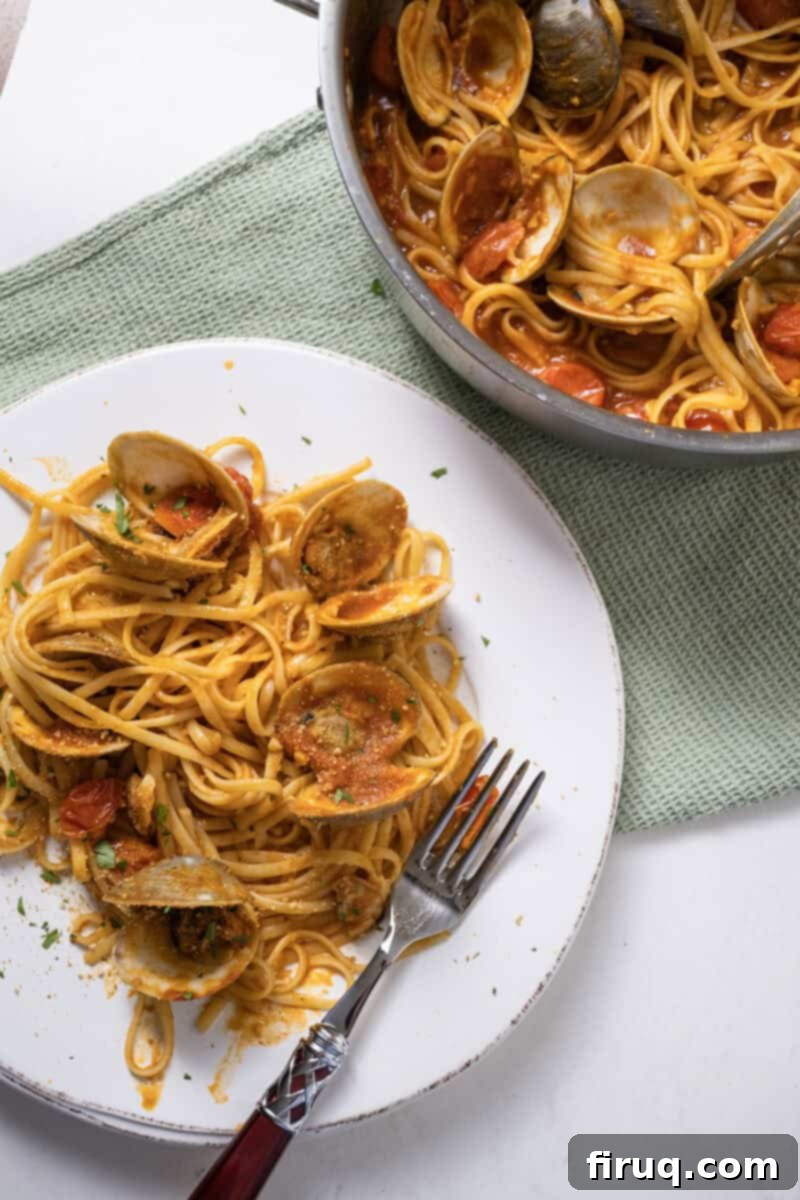
Linguine with Red Clam Sauce: Your Questions Answered
Reheating linguine with clams effectively requires a gentle approach to maintain the pasta’s texture and prevent the clams from becoming rubbery. The best way is to place the pasta in a non-stick pan over medium-low heat. Add a splash of water, clam juice (if you have any leftover), or a drizzle of olive oil to help rehydrate the sauce. Stir occasionally and gently until the pasta is heated through and the sauce is once again glossy and well-incorporated. Avoid high heat, as this can dry out the dish and toughen the clams.
Our vibrant red clam sauce is a delicious blend of fresh, high-quality ingredients. It features tender little neck or cherrystone clams, sweet cherry tomatoes (halved to release their juices), aromatic minced garlic, savory anchovies (which melt away to add umami), a generous splash of dry white wine for acidity and depth, concentrated tomato paste for richness, and a touch of starchy pasta water to bind and emulsify the sauce into a creamy consistency. The optional but highly recommended toasted breadcrumbs add a final flourish of texture and nutty flavor.
For pairing with linguine and red clam sauce, you have excellent options that complement its fresh and savory profile. A crisp, dry Pinot Grigio is a classic choice, offering bright acidity and subtle fruity notes that will beautifully cut through the richness of the clams and tomato without overpowering them. If you prefer red wine, a light-bodied Pinot Noir can also work wonderfully. Its delicate fruitiness and earthy undertones can surprisingly harmonize with seafood, especially with the tomatoes and garlic in the red sauce. Both wines share qualities of subtlety and pleasant flavors that enhance, rather than compete with, this delightful dish.
Leftover linguine with red clam sauce should be stored in an airtight container in the refrigerator for up to 2-3 days. While the flavors can sometimes deepen, the texture of the clams and pasta is best enjoyed fresh. It is not recommended to freeze this dish, as the clams tend to become very rubbery and the pasta can turn mushy upon thawing and reheating.
Explore More Delightful Seafood Pasta Recipes
- Creamy Pesto Shrimp Pasta
- Garlic Anchovy Pasta with Toasted Breadcrumbs
- Lemon Pesto Spaghetti with Scallops
- Cajun Shrimp Scampi
Follow us on Instagram @vindelgiudice and Tiktok @alwaysfromscratch. Leave us a review or comment below to let us know what you think of this recipe!
📖 Recipe
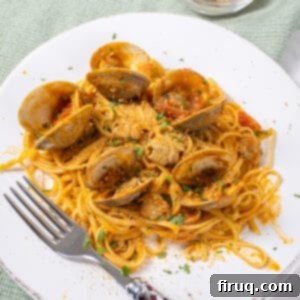
Linguine with Red Clam Sauce
Vincent DelGiudice
Pin Recipe
15 minutes
30 minutes
45 minutes
6 servings
352 kcal
Equipment
-
1 large saucepan -
1 large bowl for purging
Ingredients
-
1 lb linguine -
2 dozen clams -
3 cloves garlic, minced -
2 cups cherry tomatoes, halved -
5 anchovies -
¼ cup tomato paste -
1.5 cups white wine -
½ cup starchy pasta water -
½ cup toasted breadcrumbs
Instructions
-
Start by thoroughly scrubbing the clams under cold water. Then, purge them by placing them in a large bowl with cold, salty water for 1 hour. Carefully remove the clams, discard the water, and repeat the process with fresh cold, salty water for another hour. Finally, rinse the clams well before cooking.
-
In a shallow saucepan, heat 2 tablespoons of olive oil over medium heat until shimmering. Add the minced garlic and anchovies; sauté until the garlic is fragrant and the anchovies have melted away (about 2-3 minutes). Stir in the tomato paste and let it caramelize on the pan for 2 minutes, combining with the garlic. Add the halved cherry tomatoes and gently press them to help them break down. Sauté for another 5-8 minutes until the tomatoes soften and release their juices.
-
Meanwhile, bring a large pot of water to a rolling boil and generously salt it. Add the linguine and cook until it is just before al dente (still very firm but bendable).
-
Add the white wine to the tomato mixture in the saucepan and bring to a simmer. Ladle ½ cup of the starchy pasta water from the linguine into the sauce. Continue to simmer for 5 minutes, allowing the flavors to meld.
-
Add the rinsed clams to the pot, cover tightly, and cook for 3-4 minutes, or until all the clams have opened. Discard any unopened clams. Transfer the nearly al dente linguine directly into the sauce. Stir well to combine, ensuring the pasta is fully coated. Let the pasta simmer in the sauce for another 2 minutes to absorb the flavors. Remove from the heat and serve immediately, garnished generously with toasted breadcrumbs.
Notes
- Purging the clams is the most important step. Make sure to scrub them completely clean and purge them in cold, salty water (changing the water once) to remove as much sand from them as possible. Otherwise, you’ll be chewing on grit.
- Pasta water is liquid gold. Make sure to add that starchy liquid to help emulsify the sauce and make the pasta more creamy and luxurious, without the need for dairy.
- Don’t overcook the clams. Try to time the pasta to finish just as the clams are opening so you can add it right away. Overcooked clams will become rubbery.
Nutrition
Calories: 352kcal
Carbohydrates: 68g
Protein: 13g
Fat: 2g
Saturated Fat: 0.4g
Polyunsaturated Fat: 1g
Monounsaturated Fat: 0.3g
Cholesterol: 2mg
Sodium: 171mg
Potassium: 447mg
Fiber: 4g
Sugar: 5g
Vitamin A: 412IU
Vitamin C: 14mg
Calcium: 53mg
Iron: 2mg
Tried this recipe?
We’d love for you to Leave a Review!
